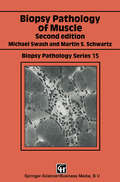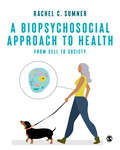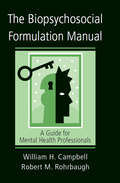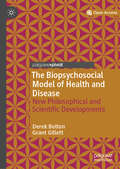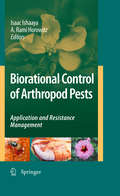- Table View
- List View
Biopsy Pathology of Muscle (Biopsy Pathology Series)
by Michael Swash Martin S. SchwartzMuseie biopsy is a long-established technique in clinical practice having been introduced by Duchenne in 1868 (Arch. Gen. Med. , 11, 5-179). However, the needle method used by Duchenne was not generally adopted, although Shank and Hoagland described a similar technique in 1943 (Science, 98, 592), and open muscle biopsy has for long been preferred in clinical practice, even with the advent of newer needle biopsy methods (Bergstrom, 1962, Scand. J. Clin. Lab. Invest. , 14, Suppl. 68, 1-110). The development of enzyme histochemical techniques has contributed greatly to knowledge of muscle pathology. More recently electron microscopy and immunocytochemistry have also been applied to clinical diagnosis of neuromuscular disease. This book is intended to serve as a practical guide in muscle pathology, particularly for histopathologists, and for those in training. As enzyme histochemistry has become more widely available, formalin-fixed methods have become less frequently used in muscle biopsy work. In this new edition of Muscle Biopsy Pathology we have taken account of the advances in classification and histological technique, and in knowledge of neuromuscular diseases, that have emerged since the first editionwas published in 1984. We hope that this book will continue to be used as a practical guide in the diagnosis and understanding of these disorders. 1. Introduction 1. 1 Generalfeatures of muscle The differentiation of musde into red and white types is a feature of all vertebrates and, indeed, of chordates.
Biopsy pathology of muscle (Biopsy Pathology Series)
by Michael Swash Martin S. SchwartzDuring the last 20 years the development of enzyme histochemical techniques has contributed greatly to knowledge of muscle pathology. However, these and other new methods, such as electron microscopy and immunocytochemistry, have only relatively recently become gener ally available for routine use in histopathology. Muscle biopsy is a long-established technique in clinical practice, having been introduced by Duchenne in 1868 (Arch. Gen. Med. , 11, 5-179). However, the needle method used by Duchenne was not generally adopted, although Shank and Hoagland described a similar technique in 1943 (Science, 98, 592). During this time muscle biopsies required a surgical procedure and this was a considerable disincentive to their use. It was not until Bergstrom (1962; Scand. J. Clin. Lab. Invest. , 14, Suppl. 68) and Edwards (1971; Lancet, ii, 593--6) developed a simple biopsy needle suitable for muscle work in connection with exercise physiology that the advantages of needle muscle biopsies came to be appreciated. Since then, muscle biopsies have become a relatively minor procedure. This has led to the increasing use of muscle biopsy in clinical practice, both for diagnosis and for assessing progress in repeated biopsies during the course of a disorder and its treatment. The full range of enzyme histochemical and ultrastructural histological techniques can be applied to these small biopsies and many of the older histological staining methods can also be used. This book is intended to serve as a practical guide in muscle pathology, particularly for histopathologists, and for those in training.
Biopsy Pathology of the Bronchi (Biopsy Pathology Series)
by Elizabeth M. McDowell Theodore F. BealsBiopsy Pathology of the Bronchi is intended to provide the practicing pathologist with a convenient source of diagnostic information, combined with pertinent clinical patterns and a background of histogenesis. It is hoped that the book will facilitate the accuracy of diagnosis, minimize pitfalls of interpretation and assist in the rapid evaluation of acute and chronic bronchial lesions, including neoplasms. Biopsy is taken in the widest sense and the book includes discussions on cytology, microbiopsies (fine needle aspiration biopsies, curette samples, and biopsies obtained by microforceps) and macrobiopsies, obtained at the time of surgery. Part I of the book deals with the procurement and preparation of bronchial specimens and includes a chapter on fetal development and structure of the normal adult epithelium. In Part II, the histopathology of numerous bronchial diseases are described in detail. Emphasis is placed on the diagnostic features of human lesions' which are illustrated by numerous high quality light and electron micrographs. Understanding normal bron chial structure, cell kinetics, and modulations of phenotypic expression provide insight into many pathological processes. Therefore, although emphasis is placed on the diagnostic features of human disease, the histopathology of corresponding lesions in experimental animals is dis cussed where this provides information helpful in the interpretation of the human lesions. Elizabeth M. McDowell Baltimore Theodore F. Beals Ann Arbor 1985 viii Acknowledgments We give thanks to friends and colleagues who reviewed one or more chapters for us during the writing of this book.
Biopsy Pathology of the Lymphoreticular System (Biopsy Pathology Series)
by Dennis H. Wright Peter G. IsaacsonBiopsychologie von A bis Z (Springer-Lehrbuch)
by Clemens KirschbaumBiopsychologie von A bis Z – von Acetylcholinesterase über Hypogeusie bis hin zu Zytosol. Hier finden Sie alle Fachbegriffe zum schnellen Nachschlagen. Biopsychologie ist ein extrem spannendes Fach, verfügt aber vermutlich über die höchste Anzahl an Fachbegriffen. Für dieses Buch definierten 30 Studenten und Studentinnen über 2000 biopsychologische Fachbegriffe. Der Experte Clemens Kirschbaum prüfte die Korrektheit. Sämtliche Beschreibungen sind leicht verständlich, so exakt wie nötig und dabei so einfach wie möglich formuliert. Sie sind alphabetisch sortiert und mit englischen Übersetzungen versehen. Plus: Online-Version im Internet.
Biopsychologische Faktoren des Hyperkinetischen Syndroms: Eine multimodale Theorie und Forschungsstrategie (Lehr- und Forschungstexte Psychologie #44)
by Burkhard BrockeBiopsychology: Physiological Psychology (Introductory Psychology Series)
by Sheila HaywardBiopsychology provides an examination of the human physiological mechanisms and structures and the influence that these have over the thoughts and behaviours of the individual. In addition, it discusses the influence of the mind over the body. The text is well-illustrated and clearly presents the student with topics covered by A-level syllabuses.
Biopsychology, Global Edition (PDF)
by John P. J. Pinel Steven BarnesFor courses in Physiological Psychology and Biopsychology Explore how the central nervous system governs behaviorBiopsychology presents a clear, engaging introduction to biopsychological theory and research through a unique combination of biopsychological science and personal, reader-oriented discourse. Original author John Pinel and new co-author Steven Barnes address students directly and interweave the fundamentals of the field with clinical case studies, useful metaphors, and memorable anecdotes that make course material personally and socially relevant to readers. In addition to expanded learning objectives that guide students through the course, the Tenth Edition has been thoroughly updated to reflect this rapidly progressing scientific field. MyLab(tm) Psychology not included. Students, if MyLab is a recommended/mandatory component of the course, please ask your instructor for the correct ISBN and course ID. MyLab should only be purchased when required by an instructor. Instructors, contact your Pearson representative for more information. MyLab Psychology is an online homework, tutorial, and assessment product designed to personalize learning and improve results. With a wide range of interactive, engaging, and assignable activities, students are encouraged to actively learn and retain tough course concepts.
The Biopsychology of Mood and Arousal
by Robert E. ThayerWhat is the biological function of daily mood variations? What is the relationship between mood and such factors as exercise, time of day, nutrition, stress, and illness? Drawing on his own wide-ranging research concerning subjective assessments of mood and on extensive research by others, Dr. Thayer presents a comprehensive theory of normal mood states, viewing them as subjective components of two biological arousal systems, one which people find energizing, and the other which people describe as producing tension. The author explains these two mood effects in relation to a complex relationship between energy and tension. Relevant research is systematically reviewed, and moods are analyzed in relation to circadian rhythms, exercise, nutrition, sleep, stress, and cognition. Perceptual and motivational effects of mood are also discussed, as are measurement and research design issues. Unique in its depth and comprehensiveness, this book will be of interest not only to researchers in psychology, biology, and medicine, but its clear style of presentation and the practical activities suggested for mood regulation will make it interesting to general readers as well.
A Biopsychosocial Approach to Health: From Cell to Society
by Rachel C. SumnerThis unique text takes a holistic approach to show you how different biological and medical aspects of health operate at the cellular level all the way up to the societal level, and back again. It explains key biological aspects of health at the cellular level (such as epigenetics and oxidative stress) to give you a solid understanding of how health is created in the context of the person, before working upwards to examine public health issues ranging from cardiovascular disease to unemployment and loneliness. Throughout the text, you will encounter a diverse range of cross-cultural examples, real-world scenarios and key questions which will help you put the theories and cell-to-society perspective you have learned into practice. With interdisciplinary perspectives from psychoneuroimmunology and epidemiology, this book offers an integrated consideration of health and its biopsychosocial determinants. It is a must-read for students of health psychology, applied psychology, nursing, and public health. Rachel C. Sumner is a psychobiologist and chartered psychologist with the British Psychological Society Division of Health Psychology and a senior research fellow at Cardiff Metropolitan University.
A Biopsychosocial Approach to Health: From Cell to Society
by Rachel C. SumnerThis unique text takes a holistic approach to show you how different biological and medical aspects of health operate at the cellular level all the way up to the societal level, and back again. It explains key biological aspects of health at the cellular level (such as epigenetics and oxidative stress) to give you a solid understanding of how health is created in the context of the person, before working upwards to examine public health issues ranging from cardiovascular disease to unemployment and loneliness. Throughout the text, you will encounter a diverse range of cross-cultural examples, real-world scenarios and key questions which will help you put the theories and cell-to-society perspective you have learned into practice. With interdisciplinary perspectives from psychoneuroimmunology and epidemiology, this book offers an integrated consideration of health and its biopsychosocial determinants. It is a must-read for students of health psychology, applied psychology, nursing, and public health. Rachel C. Sumner is a psychobiologist and chartered psychologist with the British Psychological Society Division of Health Psychology and a senior research fellow at Cardiff Metropolitan University.
A Biopsychosocial Approach to Health: From Cell to Society
by Rachel C. SumnerThis unique text takes a holistic approach to show you how different biological and medical aspects of health operate at the cellular level all the way up to the societal level, and back again. It explains key biological aspects of health at the cellular level (such as epigenetics and oxidative stress) to give you a solid understanding of how health is created in the context of the person, before working upwards to examine public health issues ranging from cardiovascular disease to unemployment and loneliness. Throughout the text, you will encounter a diverse range of cross-cultural examples, real-world scenarios and key questions which will help you put the theories and cell-to-society perspective you have learned into practice. With interdisciplinary perspectives from psychoneuroimmunology and epidemiology, this book offers an integrated consideration of health and its biopsychosocial determinants. It is a must-read for students of health psychology, applied psychology, nursing, and public health. Rachel C. Sumner is a psychobiologist and chartered psychologist with the British Psychological Society Division of Health Psychology and a senior research fellow at Cardiff Metropolitan University.
Biopsychosocial Approaches in Primary Care: State of the Art and Challenges for the 21st Century
by Hoyle LeighST MEDICINE IN A CHANGING UNIVERSE AT THE THRESHOLD OF THE 21 CENTURY Hoyle Leigh, M. D. I Professor ofPsychiatry San Francisco, University ofCalifornia, and Fresno VAMedical Center INTRODUCTION During my lifetime, the universe has changed beyond recognition. The universe into 111 which I was born, in the first halfofthe 20 century, was still infinite, permanent, orderly, and tranquil --- a universe that worked like a masterfully constructed clock. Matter and energy followed Newton's lawsofconservation. Shortly after my birth, Hiroshima proved, with a big bang, that matter was no longer permanent, everything was relative. Einstein had also shown thateverything that happened was local, that is, there was an event horizon beyond which no information could reach as nothing can travel faster than light. When I was growing up, the moon was for lovers, and going there was an impossible dream. Cosmologically, the Big Bang theory that postulates that the universe was born out ofan explosion some 10-15 billion years ago from a primordial point won over steady state. Ithas been expanding ever since, although the ultimate fateofthe universe is still unknown whetherit will keep on expanding resulting in aperpetual stateofheat death, or will at some point startcontracting, resulting in a big crunch ofgravitational collapse ending in a single black hole out ofspace, time, and existence. Quantum theory has defeated even Einstein's genius and proven that God indeed plays dice.
Biopsychosocial Approaches to Understanding Health in South Asian Americans (Cross-Cultural Research in Health, Illness and Well-Being)
by Edward C. Chang Marisa J. PereraThis volume is the first comprehensive and interdisciplinary text to holistically improve understanding of the health of South Asians residing in the United States by considering biological, psychological, and sociocultural factors of health. The vast literatures of diverse fields – psychology, medicine, public health, social work, and health policy – are integrated by leading scholars, scientists, and practitioners in these areas to explore the impact of South Asian cultural factors on health, health risk, and illness. Chapters incorporate available theoretical and empirical information on the status of chronic health conditions in South Asians in the United States, with consideration of future directions to improve understanding of the health of this group. Cultural and ethnic insights imperative for clinical/community/medical practitioners to provide effective and culturally-appropriate care and treatment from an interdisciplinary lens are provided.
Biopsychosocial Factors of Stress, and Mindfulness for Stress Reduction
by Holly Hazlett-StevensThis volume brings together basic research on the nature of stress reactivity with up-to-date research on the effectiveness and mechanisms of mindfulness interventions. The chapters review the major research areas that elucidate the impact of stress reactivity on health, and explore the mechanisms and effectiveness of mindfulness-based approaches for stress reduction and improved physical and emotional health. The first section examines biopsychosocial mechanisms of stress reactivity such as allostasis and allostatic load, neurobiology of stress, biology of the “fight-or-flight” and “tend-and-befriend” responses, and psychoneuroimmunology. This section concludes by addressing the roles of perception and appraisal, including the role of perceived threat in stress reactivity as well as the role that negative perceptions of the stress response itself play in compromising health. The second section opens with review of leading psychological models of mindfulness, including self-regulation, reperceiving, and the Intention, Attention, Attitude (IAA) triaxiomatic model. Subsequent chapters discuss mindfulness-based interventions and mechanisms of change for stress and related clinical conditions including chronic pain, traumatic stress, anxiety and related disorders, and clinical depression. The final chapter reviews possible neural networks and brain mechanisms associated with mindfulness meditation practice. As the research on stress reactivity and mindfulness-based stress reduction continues to proliferate, this book offers readers a single volume covering the most relevant information across this vast terrain. Other available volumes offer in-depth coverage of stress research with little mention of mindfulness and stress reduction. Conversely, many texts on the topic of mindfulness and mindfulness-based interventions do not adequately cover the biopsychosocial processes of stress reactivity.
The Biopsychosocial Formulation Manual: A Guide for Mental Health Professionals
by William H. Campbell Robert M. RohrbaughBased on George Engel’s model, The Biopsychosocial Formulation Manual presents ways to help psychiatry residents and students effectively gather and organize patient data to arrive at a complete mental health history in a limited timeframe. While most current models only take one factor into account, Campbell and Rohrbaugh emphasize and analyze three essential components (biological, social, and psychological). The process of identifying pertinent data for each component of the biopsychosocial formulation is explicated in detail. A separate section outlines how to use the biopsychosocial formulation to generate treatment recommendations. This volume includes a complete package for practicing the biopsychosocial method; this easy-to-use guide includes a data record sheet and a companion CD to facilitate organization and assessment, appealing to both the psychiatric professional and the trainee.
The Biopsychosocial Formulation Manual: A Guide for Mental Health Professionals
by William H. Campbell Robert M. RohrbaughBased on George Engel’s model, The Biopsychosocial Formulation Manual presents ways to help psychiatry residents and students effectively gather and organize patient data to arrive at a complete mental health history in a limited timeframe. While most current models only take one factor into account, Campbell and Rohrbaugh emphasize and analyze three essential components (biological, social, and psychological). The process of identifying pertinent data for each component of the biopsychosocial formulation is explicated in detail. A separate section outlines how to use the biopsychosocial formulation to generate treatment recommendations. This volume includes a complete package for practicing the biopsychosocial method; this easy-to-use guide includes a data record sheet and a companion CD to facilitate organization and assessment, appealing to both the psychiatric professional and the trainee.
The Biopsychosocial Model of Health and Disease: New Philosophical and Scientific Developments
by Derek Bolton Grant GillettThis open access book is a systematic update of the philosophical and scientific foundations of the biopsychosocial model of health, disease and healthcare. First proposed by George Engel 40 years ago, the Biopsychosocial Model is much cited in healthcare settings worldwide, but has been increasingly criticised for being vague, lacking in content, and in need of reworking in the light of recent developments. The book confronts the rapid changes to psychological science, neuroscience, healthcare, and philosophy that have occurred since the model was first proposed and addresses key issues such as the model’s scientific basis, clinical utility, and philosophical coherence. The authors conceptualise biology and the psychosocial as in the same ontological space, interlinked by systems of communication-based regulatory control which constitute a new kind of causation. These are distinguished from physical and chemical laws, most clearly because they can break down, thus providing the basis for difference between health and disease. This work offers an urgent update to the model’s scientific and philosophical foundations, providing a new and coherent account of causal interactions between the biological, the psychological and social.
Biopsychosocial Perspectives on Arab Americans: Culture, Development, and Health
by Sylvia C. Nassar Kristine J. Ajrouch Florence J. Dallo Julie Hakim-LarsonThe biopsychosocial study of Arab Americans yields compelling insights into innovative theoretical and applied initiatives. In the context of a growing population of Arab Americans, coupled with the current tenure of xenophobia and exposed structural racism in the US, clinical and community practitioners must be attuned to their clients of Arab ancestry, whose experiences, development, and health concerns are distinctly different than that of their White counterparts. This second edition, with its uniquely interwoven sections of culture, psychosocial development, and health and disease, provides a rich overview of timely, critical topics. The audience for the text includes counselors, social workers, psychologists, nurses, psychiatrists, sociologists, and any other public and mental health practitioners, researchers, and policy makers who work with and on behalf of clients and patients of Arab descent. The authors represent a team of leading experts spanning disciplines of sociology, clinical mental health, and community public health. "This edition draws on leading experts in Arab American health and sociology who document the complexity of this population's immigration and acculturation experience. It offers critical and current research that speaks to the centrality of context and diversity in treating Americans of Arab descent. Contributors explore the complex and limited racial framework within which Arabs in the U.S. form their identities, and the impact of structural racism on their lives and health. This collection offers practitioners much needed insights on a population often hidden or rendered invisible by data limitations, and yet misrepresented by cultural stereotypes." Helen Hatab Samhan, Former Executive Director, Arab American Institute/Foundation. "Nassar, Ajrouch, Hakim-Larson, and Dallo’s breakthrough work in the area of culturally competent health care has been inspiring across interdisciplinary fields and to the communities they serve. Their work on Arab American health issues, in particular, has greatly improved clinical practice at the community and national levels. I heartily recommend taking the time to become familiar with their important body of work and this latest text."Ismael Ahmed, Former Michigan State Director of Health and Human Services.
Biopsychosocial Perspectives on Arab Americans: Culture, Development, and Health
by Sylvia C. Nassar-McMillan Kristine J. Ajrouch Julie Hakim-LarsonThis book introduces an interdisciplinary lens by bringing together vital research on culture, psychosocial development, and key aspects of health and disease to address a wide range of salient concerns. Its scholarship mirrors the diversity of the Arab American population, exploring ethnic concepts in socio-historical and political contexts before reviewing findings on major health issues, including diabetes, cancer, substance abuse, mental illness, and maternal/child health. And by including policy and program strategies for disease prevention, health promotion, and environmental health, the book offers practitioners--and their clients--opportunities for proactive care. Featured in the coverage: Family, gender and social identity issuesArab Americans and the aging processAcculturation and ethnic identity across the lifespanArab refugees: Trauma, resilience, and recoveryCancer: Crossroads of ethnicity and environmentHealth and well-being: Biopsychosocial prevention approachesArab American health disparities: A call for advocacy Rich in cultural information and clinical insights, Biopsychosocial Perspectives on Arab Americans is an important reference that can enhance health practices across the disciplines of medicine, nursing, rehabilitation, social work, counseling, and psychology.
Biopsychosocial Perspectives on Transplantation
by James R. RodrigueThe field of transplantation has grown exponentially over the last few decades, and leaders in the field may argue that we have seen only the tip of the iceberg. Perhaps in no other discipline is there a need for multidisciplinary dialogue, debate, and approaches to patient care. In preparing this book, we have attempted to introduce readers to a few of the key clinical and ethical issues confronting the field of transplantation today. In so doing, we recognize that the face of transplantation may change dramatically in the years to come. Nevertheless, the issues raised throughout this book will serve as a useful introduction to important clinical issues and as a catalyst for clinicians and researchers to expand the horizons of transplantation. Health professionals involved in evaluating and treating transplant patients must be knowledgeable of the indications for transplantation and patient outcomes and the process of evaluation and management. Chapters 1 and 2, focusing on solid organ transplantation and blood/marrow transplantation, provide this important contextual information. The next two chapters address what is often considered the most significant issue facing the field of transplantation - organ donation. While the number of patients needing transplantation has risen dramatically in recent years, the rate of organ donation has remained relatively stable. Chapter 3 highlights the many ethical issues surrounding the more general concept of organ donation, while Chapter 4 focuses specifically on the burgeoning interest in living organ donation.
Bioptische, bio- und fermentchemische Magenuntersuchungen (Forschungsberichte des Landes Nordrhein-Westfalen #1123)
by Leo Norpoth Theo SurmannBioradicals Detected by ESR Spectroscopy (Molecular and Cell Biology Updates)
by Hiroaki Ohya-Nishiguchi Lester PackerThis book is based on two keywords: Bioradical and ESR. Bioradical is a newly coined word which encompasses paramagnetic species in biological systems, such as active oxygen radicals and transition metal ions. Research on the structure and function of bioradicals has been attrac ting growing attention in the field of biological science, and comprehensive investigations from many fields are helping to understand the real features of these species. ESR spectroscopy also has interdisciplinary features in that its techniques have been applied to many fields, ranging from physics to medicine. It was our hope, therefore, that this book would help to clarify many aspects of bioradicals and that significant progress would be achieved in combining basic research from many different fields. This book arises from the First International Conference on Bioradicals Detected by ESR Spectroscopy (ICBES), which was held in Yamagata, a city in the Yamagata Prefecture of Japan, in 1994. About 300 participants from 16 different countries attended this conference, and about 170 papers were presented. This book is a collection of contributions from the conference and also contains eleven chapters selected by the editorial board, based on sugges tions from the members of the international editorial board of ICBES. The Yamagata Technopolis Foundation is developing a biomedical technology for the 21st century based on life science fused with material and physical science. Based on such a techno logy, the Foundation plans to share its fruits all over the world.
Biorational Control of Arthropod Pests: Application and Resistance Management
by Isaac Ishaaya A. Rami HorowitzFor nearly 50 years, pest control was mostly based on broad-spectrum conv- tional insecticides such as organochlorines, organophosphates, carbamates and pyrethroids. However, the severe adverse effects of pesticides on the environment, problems of resistance reaching crisis proportions and public protests led to stricter regulations and legislation aimed at reducing their use. Ways to reduce the use of synthetic pesticides in plant protection and to use more alternative and novel me- ods for pest control or biorational control are the challenges of pest control for the twenty-first century. The term biorational (biological + rational) pesticides can be defined as the use of specific and selective chemicals, often with a unique modes of action, that are compatible with natural enemies and the environment, with minimal effect on n- target organisms. Biorational control is based on a diversity of chemical, biological and physical approaches for controlling insect pests which results in minimum risk to man and the environment.
Bioreaction Engineering: Modeling and Control
by K. Schügerl K. H. BellgardtAlongside presenting the fundamentals, this book reviews the state of the art of mathematical modeling and control of bioprocesses, while demonstrating the application in various biological systems important to industry. At the same time, the application of different types of models and control strategies are illustrated, taking into account the recent developments in reactor modeling. In addition to modeling and control, the metabolic flux analysis and the metabolic design and their application to bioprocesses are considered.
